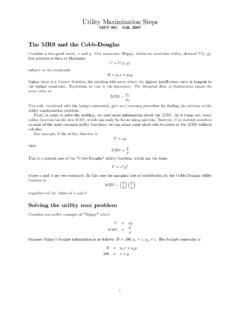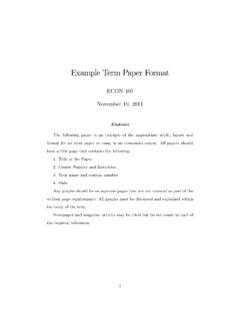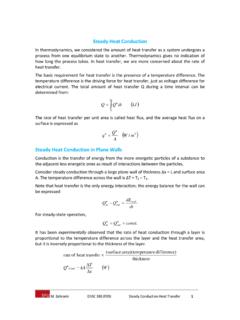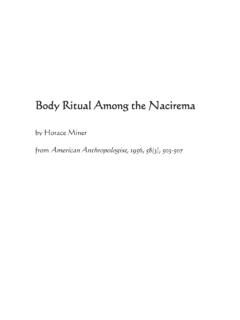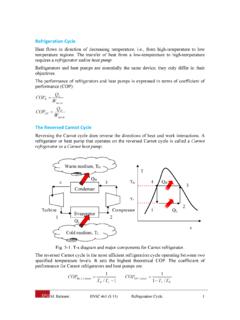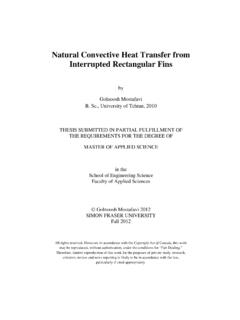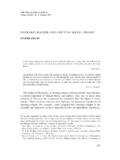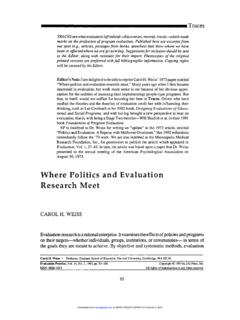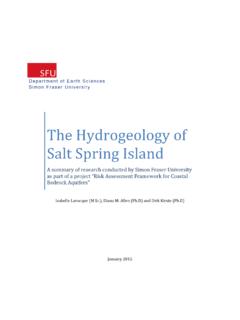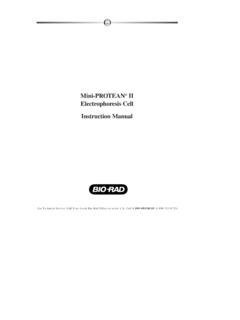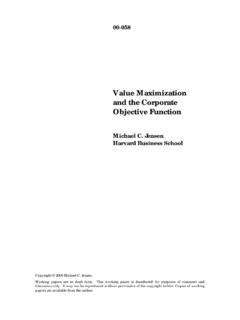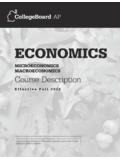Transcription of THE FIRM’S PROFIT MAXIMIZATION PROBLEM - SFU.ca
1 Simon Fraser UniversityProf. KaraivanovDepartment of EconomicsEcon 301 THE firm S PROFIT MAXIMIZATION PROBLEMT hese notes are intended to help you understand thefirm s PROBLEM of maximizing profitsgiven the available technology. Both a general algebraic derivation of the PROBLEM and theoptimality conditions and specific numerical examples are presented. This is done separatelyfor the short and long MAXIMIZATION - OverviewWe assume thatfirms are in business to make as much money as possible, they striveto maximize their profits . This assumption has its rationale in the idea of natural selection or survival of thefittest - if afirm is not maximizing profits its competitors who do wouldeventually drive it out of business by employing more efficient (and more profitable) methodsof production.
2 Even if thefirm is monopoly, however it would most probably want to maximizeprofits - after allfirms are owned by people form whom we assumed more is always morefirm s PROFIT would mean more income (or wealth) for its owners which makes themhappier. Thus PROFIT MAXIMIZATION seems a reasonable assumption aboutfirms behavior. Thefirm maximizes profits (revenues minus costs) by choosing the most efficient way to produce, by choosing the optimal amounts of the factors of production to employ. Thefirm choosesthese optimal amounts taking into account the available technology embodied in the productionfunction which gives the relationship between the amounts of inputs put into production andthe maximum possible amount of output that can be vs Long RunThefirm s PROBLEM of maximizing profits differs between the short and the long run.
3 Re-member that we call the short run a time period in which at least some factors of productionarefixed. Thus in the short run thefirm is unable to vary all factors - some of them arefixed atpredetermined levels and cannot be changed. Thus the only thing that thefirm can choose inthis case is the quantities ofvariable inputs(notfixed) to hire. For example we can imaginethat we produce output using labor and a plant and the size of the plant isfixed in the longrun. The only choice variable for the owner of suchfirm in the short run (the only thing thatcan be varied to maximize profits ) is then the number of people contrast, in the long run all factors are variable so thefirm can choose how much to hireofall inputs,which makes its PROBLEM a bit more complicated. In our example above, theowner of thefirm can choose both the number of people to hire and the size (or number) simplify things, in the discussion below we will use an example with 2 inputs and oneoutput.
4 We will use the following notation:-x1,x2- the quantities of the two inputs hired by thefirm1-y=f(x1,x2) the amount of output produced fromx1andx2wheref(x1,x2)istheproduction function-w1,w2- the per unit market prices (wages) for the two inputs-p- the market price of outputWe will assume that thefirm takes input and output pricesw1,w2andpas given - itcannot influence them. Thus we are looking at the case where both input and output marketsarecompetitive(eachfirm is too small to affect the prices). PROFIT MAXIMIZATION in the Short RunSince we are in the short run (SR) assume that factor 2 for example isfixed, x2(we just have our single factory). Thefirm s PROBLEM then is to maximize profits by choice ofx1- the amount of input 1 to be hired. Notice that thefirm cannot choose anything else here- prices are assumed to be taken asfixed for thefirm, x2isfixed and output is just a functionofx1and have chosenyas s PROBLEM is then:maxx1pf(x1, x2) w1x1 w2 x2In words, the above says - maximize profits (=revenue (py)minuscosts(w1x1+w2 x2)) bychoosing the optimal quantity of input 1 (x1) to hire.
5 It looks like the consumer PROBLEM butthere is no constraint. Why? Aren tfirms constrained? Yes, they are, the constraint is actuallythere - it is just plugged in into the PROFIT function - remember that the constraint onfirm sbehavior is put by nature - it is the production function, saying that output,ymust equalf(x1, x2) be chosen independently is a simple MAXIMIZATION PROBLEM of one variable so we just need to take thefirstderivative of the function that is beingmaximized and set it equal to zero. We get:pf1(x1, x2) w1=0(1)wherewedenotebyf1(x1, x2) the derivative of the production function with respect that x2is treated as a parameter, a constant which it above equation can be solved for the optimal quantity of factor 1,x 1that thefirmwill use to achieve highest profits .
6 We callx 1the factor demandfor input 1. Just as in theconsumer theory, it will be a function of the prices in general, 1=x 1(p, w1,w2).This equation has a very nice economic interpretation. Remember what isf1(x1, x2) (thederivative of the production function with respect tox1) it is simply the slope of the pro-ductionfunctionatx1,orinotherwords-t he marginal product of factor equation (1) is saying thatat optimumwe must have:pMP1=w1(2)2 What does this mean? Remember what was the marginal product (MP1)-itwastheincrement in output obtained by hiring one more unit of input 1. Multiply this by the price ofoutput and the left hand side above can be interpreted as thevalue of marginal productofinput one, the increment in revenue (money) that we would obtain if hiring one more of hiring an additionalunitof the factor.
7 Thus optimality requires thatwesettheadditionalrevenuewegetfromhi ring one more unit of the input equal to the cost of obtaining that is this optimal? Well, suppose thatpMP1>w1at our PROFIT maximizing optimum, that the additional revenue obtained from hiring one more unit of the factor is larger thanthe cost of doing so. Then we can increase our profits by hiring more of the factor untilpMP1decreases to a level equal tow1(remember hiring more units of the input holding the other inputconstant decreases itsmarginal product (MP1) due to the law of diminishing marginal product).Since we are able to increase profits we must not have been PROFIT maximizing. Similarly, if wesuppose thatpMP1<w1at the profitmaximizingpointweseethatifwereduce ourusageofinput 1 we can actually increase our profits since this last unit brings us less value (pMP1)thanwhat we have to pay for it (w1).
8 Let us compute the optimal choice ofx1(the factor demand) for the Cobb-Douglas produc-tion functionf(x1,x2)=x 1x s PROBLEM is:maxx1px 1 x 2 w1x1 w2 x2 Setting thefirst derivative with respect tox1we get:p x 11 x 2 w1=0since x2is just a constant. We can solve the above equation for the factor demand,x 1(p, w1,w2).We have:x 11=w1p x 2or (rasing both sides to power1 1)x 1=(w1p x 2)1 1 Notice that for the Cobb-Douglas function the factor demand for input 1 depends onw1andpbut not on the price of the second input, Example (different from class)Let us now consider a particular example with a specific production function and thatf(x1,x2)=x1/21x1/22,w1=2,w2=1,p=4and x2= as above, thefirm s PROBLEM is (just substituting the numbers):maxx14x1/21(1)1/2 2x1 (1)(1)3 Taking the derivative and setting to zero:412x 1/21 2=0or,2x 1/21=2orx 1/21= 1=1(you could have obtained the same expression by substituting the specific numerical valuesused here forp, x2,w1, , in the general expression from before).
9 Having the optimal quantity demanded of theinputwecancomputetheoptimalamountof output that will be produced by simply pluggingx 1into the production function. We get,y =f(x 1, x2)=(1)1/2(1)1/2= can alsofind the maximized PROFIT , =py w1x 1 w2 x2=4(1) 2(1) 1=1.(everything turns out to be equal to one in this example :-) ) PROFIT MAXIMIZATION in the Long RunNow consider the long run - when all factors are variable and hence can be chosen bythefirm when deciding how to maximize profits . The difference from before in our example isthat bothx1andx2can now be chosen. Thus thefirm s PROFIT MAXIMIZATION PROBLEM in thelong run looks like:maxx1,x2pf(x1,x2) w1x1 w2x2 Notice that there is no x2anymore as both inputs are to be to solve it?Now we have a function of two variables and (unlike the consumer s PROBLEM ) there is noconstraint to use to expressx2in terms ofx1or vice versa.
10 So what do we do? Well, same asbefore: take derivatives and set to zero. The difference is that now we have two variables so wehave to take the derivative of the function with respect to each of themholding the otherconstant. This is simply taking thepartial derivativeswith respect to each variable partial derivative with respect tox1(holdingx2constant) is obtained in the same wayas before:pf1(x1,x2) w1=0wheref1(x1,x2)= f(x1,x2) x1is the partial derivative offwith respect , forx2we getpf2(x1,x2) w2=0wheref1(x1,x2)= f(x1,x2) x2is the partial derivative offwith respect again the partial derivatives are simply the marginal products of the two factors, have at optimum:pMP1=w1pMP2=w2 The interpretation is the same as before - the value of marginal product of each factor mustequal its price at optimum otherwise factor usagecan be either decreased or increased yieldinghigher above represents a system of two equations that can be solved for the optimal factordemands,x 1andx 2(notice thatMP1andMP2are functions ofx1andx2).
